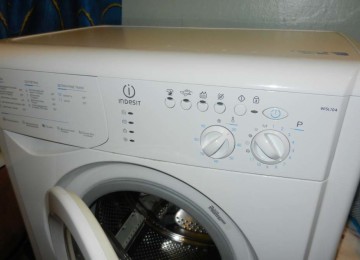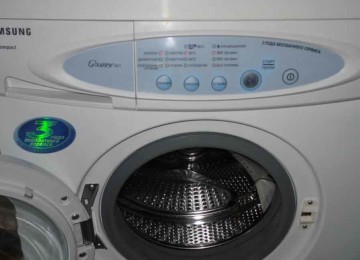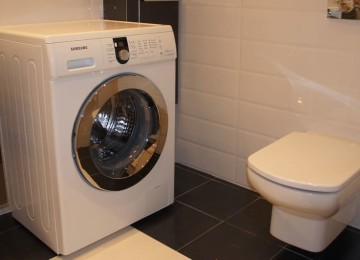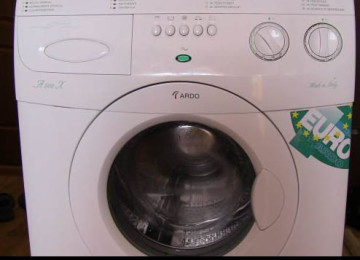Most women today do not consider washing a boring job that requires a lot of time. Today, automatic machines that can independently clean dirt from clothes help solve this problem. However, you need to know where to put the powder in the washing machine.
Powder filling location
Household chemicals used for washing are poured into the compartment provided for it - the dispenser. The dispenser may have design differences. They depend on what model of household appliance is used. Find out in which specific department you want to put the product, perhaps by looking at the existing labeling:
- The number 1 is applied to the compartment of the container intended for the double washing cycle. As for the dimensions, this container is smaller than others and is located on the right side.A small amount of dry powder is poured into it.
- The number 2 is located on the compartment designated for the main cycle. It is located on the left. Additional compounds are placed in it, for example, bleach. Many models of automatic washing machines provide for the use of both liquid bleach and powder form of the product. Leakage is prevented thanks to a special partition.
- An asterisk marks the element of the container in which the conditioner is placed. The liquid form of the product is poured into this section.
The compartment into which the conditioner is poured has an overflow valve. When the liquid level in the cap exceeds this mark, the liquid ends up in the drum. So it is recommended to use a measuring cap.
When powder is loaded into the wrong compartment, there will be no serious damage to the machine. For example, if the owner tangles the cells and the used powder gets into the wrong compartment, first of all, the quality of the wash deteriorates - the stains will remain on the clothes.
The design of some washing machines does not provide for the use of a gel product. This does not mean that it is necessary to abandon its use. After all, there are dispensers in which washing powder is placed. The filled dispensers are placed in the washing machine.
Manufacturers of household chemicals have developed their own version. They produce formulations in small bottles with a spherical cap. Once filled, they are placed in the machine.
If such devices are not available, the gel can be poured into the compartment. The product will immediately end up in the container. So the cuvette must be kept open until water fills in, with which the remaining gel is washed away inside, after which the compartment can be closed.
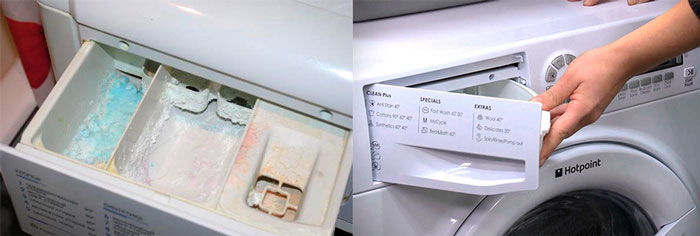
Where to put washing powder depending on the design of the equipment?
As for modern technology, it can have both front and vertical loading. In addition, there are semi-automatic washing machines. Taking this into account, the powder must be poured into various sections.
Front loading
For front-loading equipment, the hatch for storing dirty clothes is located on the front wall. Above such a hatch there is a special container. Household chemicals are poured into it. In many such devices it is divided into 3 parts. However, there are exceptions.
In case of vertical loading
The washing machine, which has a vertical loading, is equipped with a hatch with a special small compartment. Washing powder is poured into it. It can be seen by opening the unit cover.
During the semi-automatic washing process
The semi-automatic machine does not have a powder receptacle. Therefore, it is recommended to pour household chemicals into the machine drum.
For both manual and semi-automatic washing, it is permissible to use various products (they can be of different concentrations, they may or may not have a defoamer). When the detergent composition is not used for its intended purpose, serious problems can arise: foam flows through a special ditch. Often it is completely absent.
Is it possible to pour powder into the drum of a washing machine?
Pouring washing powder into the machine drum is a necessary measure. Housewives do this when the tray where they put the detergent is damaged. There is no clear point of view regarding the justification of such a step. Proponents make the following argument:
- This method allows you to extend the service life of the unit.The user also no longer needs to take care of the machine tray.
- Powder elements that enter the machine through a special tray can stick to the inner wall of the device. When it is time to rinse, they get on the laundry that is placed in the machine for washing. This does not happen when the powder is in the drum of the washing machine. Therefore, dirty clothes placed in the machine will be rinsed better.
Opponents cite the following arguments:
- Washing powder that ends up in the machine drum dissolves partially. The product added to the laundry dissolves a little longer.
- Powder granules can get on dark clothes. As a result, white marks remain on them.
- If the powder gets on the drum walls, during the start-up process, a small amount of powder is pumped out with the liquid that remained in the tank after previous washes, by a pump.
- Some machine washing programs assume that the powder is used in portions. When the product ends up in the machine drum, access to the program is lost. Soaking is considered pointless during a scheduled wash or pre-soak (draining the liquid is provided when these stages are completed). The dissolved agent, which is placed in the washing machine, is removed with the liquid before the main stage of this cycle is completed.
This method is also not suitable if conditioner or another agent intended for rinsing is added. After all, it is poured only at the last stage of the process.
Differences in the design of detergent trays among different manufacturers
The compartment for powder and other products intended for washing in the LG automatic machine is divided into 3 parts. The rightmost compartment is designated I.And also the user no longer needs to care for the machine tray.
Powder elements entering the machine through a special cuvette are capable of sticking to the inner wall of the device. When it's time to rinse, they fall on the laundry that is placed in the washing machine. This does not happen when the powder is in the drum of the washing machine. Therefore, dirty clothes placed in the machine will be rinsed better.
Opponents provide the following arguments:
The washing powder in the machine drum is partially dissolved. The product added to laundry takes a little longer to dissolve.
Powder granules may get on dark clothing. As a result, white marks remain on it.
If powder gets on the drum walls, during the start process a small volume of powder is pumped out with the liquid that remains in the tank after previous washes.
Some machine wash programs require that the powder be used in portions. When the product ends up in the machine drum, access to the program is lost.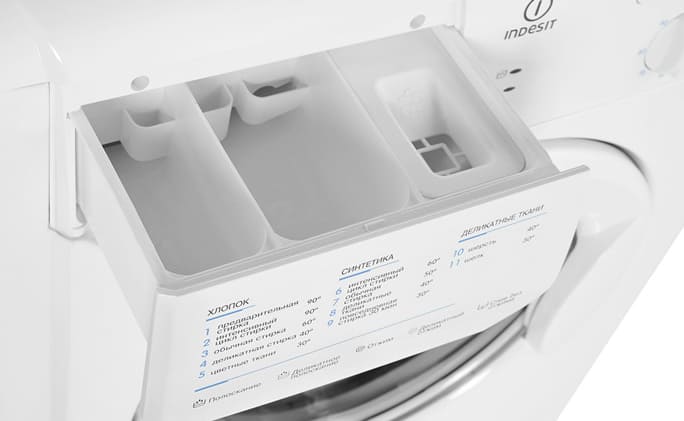 Soaking is considered pointless for scheduled washing or pre-soaking (provided for draining the liquid when these steps are completed). The dissolved detergent that is placed in the washing machine is removed with the liquid before the main stage of this cycle is completed.
Soaking is considered pointless for scheduled washing or pre-soaking (provided for draining the liquid when these steps are completed). The dissolved detergent that is placed in the washing machine is removed with the liquid before the main stage of this cycle is completed.
This method is not suitable if conditioner or other product is added that is intended for rinsing. After all, it is poured only at the last stage of the process.
Differences in the design of detergent trays between different manufacturers
The compartment for powder and other detergents intended for washing in an LG automatic machine is divided into 3 parts. The compartment on the far right is designated I.It works when you use the soak mode for washing.
The main compartment for powder is located on the left. It is larger in size, and the Roman numeral 2 is used to designate it. The rinse aid is intended for a cell on which a flower is drawn.
The Bosch washing machine tray is divided into 4 parts, 2 of them are for powder. They are larger in size.
Bosch automatic machines have a starch compartment. It is recommended to dissolve it in water before loading it into the cell.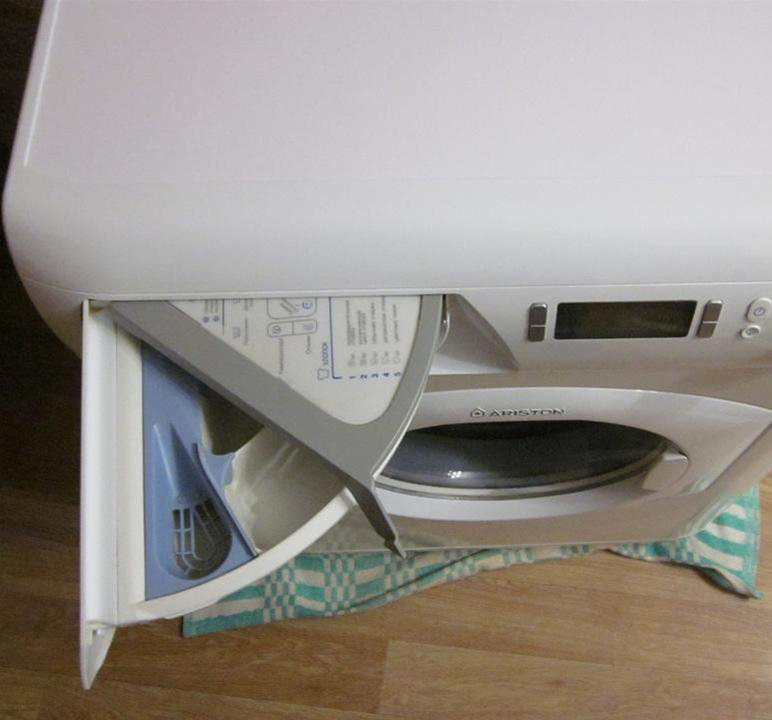 And also Bosch automatic machines, in addition to the starch compartment, have 2 cells that are smaller in size. They are designed to be filled with bleach and conditioner diluted with starch.
And also Bosch automatic machines, in addition to the starch compartment, have 2 cells that are smaller in size. They are designed to be filled with bleach and conditioner diluted with starch.
Distinctive feature of Indesit
– the presence of a cuvette where the bleaching agent is placed. There is also a compartment for liquids (you can also put bulk products there). It is located in the middle. In addition, there are 2 removable compartments. You can add not only bleach to them, but also conditioner or another product that is designed to wash dirty laundry. A product with a thick consistency is poured into one of these cells. The other compartment is for gentle washing.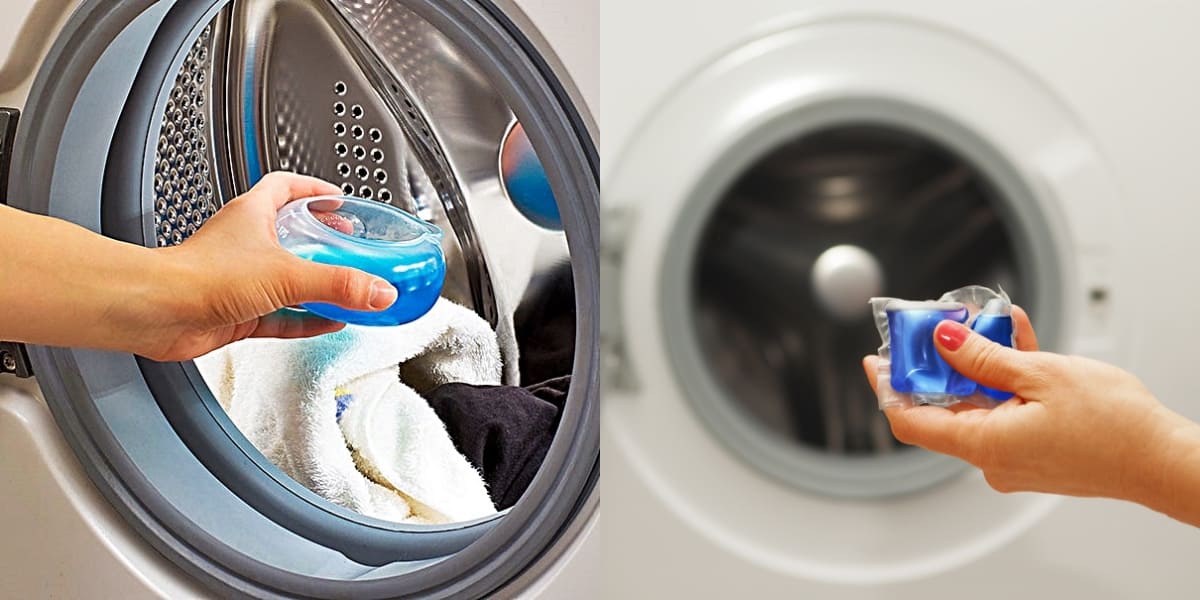
Additionally, some trays have four compartments. In 2 of them you can pour powder used for washing clothes.
- Some Samsung models have an additional compartment in the washing compartment. It is intended for loading bleach. It is recommended to remove this cell before starting a soaking program.
- The special feature of the Zanussi ZWY top-loader is that the detergent tray is divided into 4 sections.Conditioner is placed in the compartment on the far right, and bleach is placed in the one next to it. Another 2 are intended for powder during additional washing.
- The Siemens washing machine has a detergent drawer. There is a flower painted on the cover of the air conditioner compartment.
Mile WDA 100 is an expensive washing machine model. Its cuvette has 3 compartments for detergent. The air conditioner is placed in the leftmost compartment.
Regarding the Ariston washing machine
- or Gorenje, the order in which the compartments are located depends on the specific model. It is possible to understand where the washing powder is poured and not make a mistake if you have studied the instructions.
- In the case of an atypical location, you can figure out where the tray compartments for loading household chemicals are located using markings.
- Where should gels, capsules, plates be placed?
As for the liquid product that is used to wash clothes, it can be placed in:
Machine drum.
Cell equipped with markings.
Dispenser where detergent is placed.
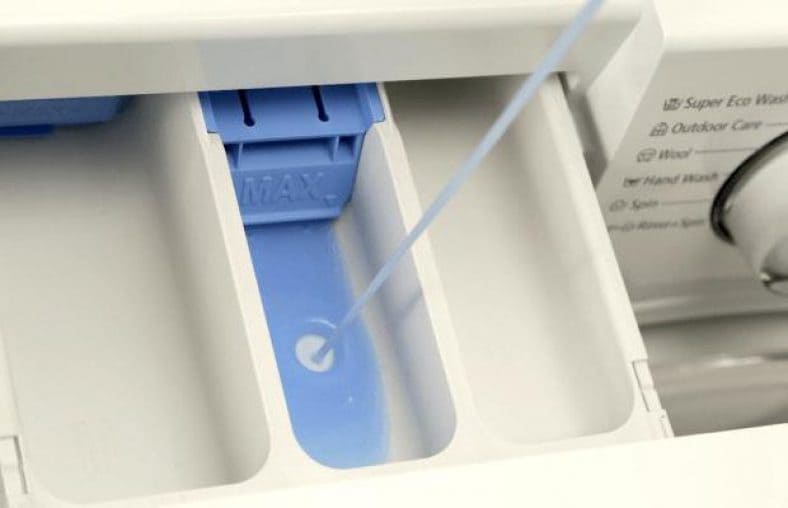
Before loading the detergent used for washing clothes into the drum of the washing machine, you should study the manufacturer's instructions. Some models of washing machines do not provide loading.
As for direct downloading, it is considered undesirable in the following cases:
The presence of bleaching elements in the detergent - as a result of direct contact, stains may form on the fabric.
The presence of components that prevent the appearance of scale (they do not achieve the desired effect).
The section used for washing already contains a small amount of powder.
As for tablets and capsules, they are most convenient for use.One tablet or capsule is enough if the load does not exceed 5 kilograms. The tablet or capsule is placed in the drum (placed in the drum makes the wash more efficient) before starting the machine, and the laundry is placed on top. Dissolution occurs quickly and the cleaning agent is distributed evenly.
Where should I fill the air conditioner?
Products that add softness to linen or have an antistatic effect are poured into a special smaller container (marked with a flower). It also often bears the Softener signature.
Some washing machine models have a level limiting mark. For example, a horizontal line labeled Max. As for antistatic agent or conditioner, they must be poured into the washing mashine so that their level is below this mark.
How to load powder into a drum in different modes 30, 60 and 90º
Contrary to popular belief among housewives, pouring cleaning product into the drum is a more economical option than pouring it into the machine tray. Of course, if the compartment breaks down and it is impossible to open it, it is advisable to send the detergent to the drum. But it will be more difficult to use prewash and many other cycles that require the correct dose of detergent. In addition, it will be impossible to completely rinse out the washing powder used for washing (particles of washing powder will remain on the internal parts of the items). This can cause severe irritation on the body if you put on underwear.
As for gels that are intended for washing, they do their job better at high temperatures. So it is better to load them at a temperature of 90 degrees (boiling mode).In addition, it is important to consider that it is recommended to pre-dissolve the gel in a warm liquid. This will allow them to quickly activate and begin to act from the first minute of washing.
At this temperature, it is not advisable to fill the drum full of laundry (the maximum allowable load volume is about 2/3 of the internal volume). It is also undesirable to put a large amount of powder or gel.
If you need to use laundry soap, but don’t want to wash your clothes, it is recommended to grate it first. After that, it goes into the drum, and the “Pre-wash” mode is selected. This program is used when laundry is heavily soiled. Smart washing machines automatically fill with the required amount of water. In this case, the powder is washed out of the compartment. The water is heated to thirty degrees, which is maintained at this level until the end of the washing process.
It is also important to consider that when washing in the “Cotton” mode (temperature − 60 degrees), 6 tablespoons of detergent, such as powder, are required. If the “Synthetic” mode (30-40 degrees) is selected, you need to add 3 tablespoons of powder.
What determines the amount of powder poured into the washing unit?
How much powder to pour into the unit depends on a number of factors. So, taking into account the level of contamination, approximately 150 grams should be added per washing procedure when there is no heavy contamination, and 225 grams when there are difficult to remove stains on the clothes.
As a rule, manufacturers write on the packaging that a similar consumption of washing powder is recommended for washing in soft water. When the water is hard, it is recommended to add an additional 20 grams of washing powder.However, it is important to take into account that manufacturers deliberately inflate spending standards.
Practice has proven that it is recommended to pour a tablespoon of cleaning product (approximately 25 grams) into a container per kilogram of moderately soiled clothing. For a 4 kilogram load you will need approximately 100 grams. If there are difficult stains, it is recommended to pre-soak the clothes before washing.
It should also be taken into account in what form the washing powder is produced. So, if it comes in tablet form, one tablet per wash is enough. As for the concentrated gel, everything is more complicated here - it is recommended to pour 100 grams of gel per load. However, this approach leads to the need to consume a large volume of detergent used for washing. As a result, more frequent purchases will be necessary. In addition, the likelihood of stains on clothing increases.
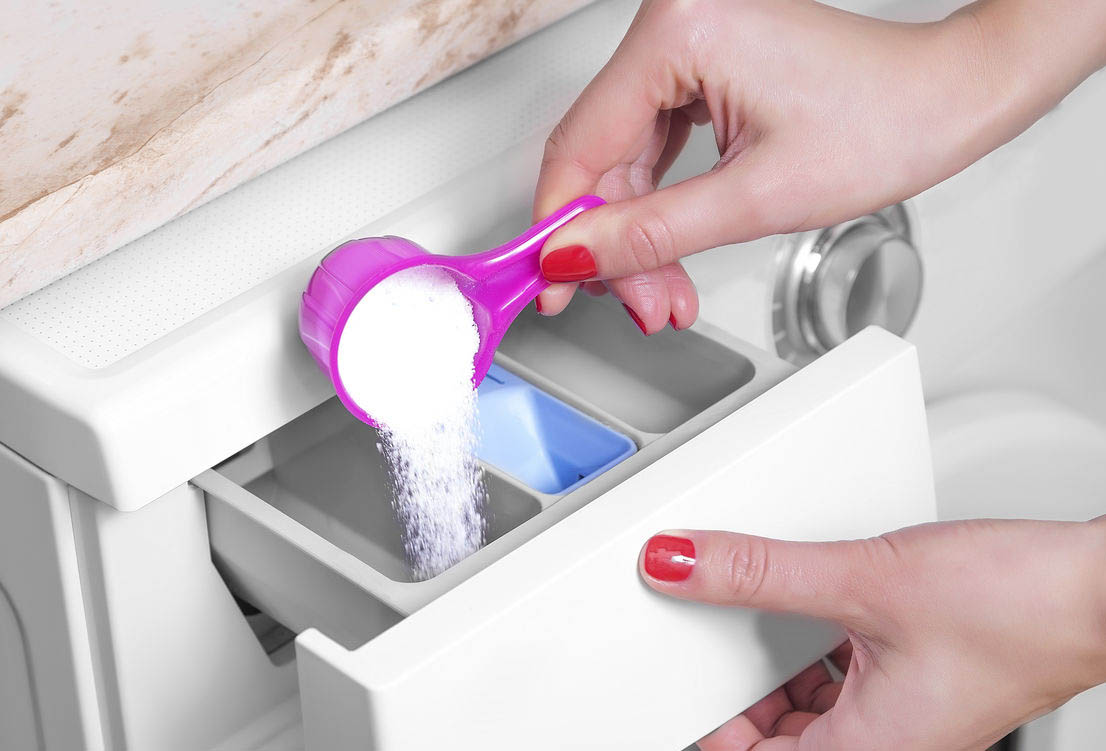
Experts recommend a different consumption rate - it is recommended to pour a maximum of one spoon of detergent per wash. If the water is hard, it is acceptable to double the recommended amount.
In addition, it is important to consider the number of things loaded into the drum. So, if there is 1 kilogram, it is permissible to pour 25 grams of washing powder into the drum, if 3.5 kilograms - 75 grams, when 4 kilograms are loaded - 100 grams. When loading 5 kilograms, you should load 125 grams of washing powder, at 6 - 175 grams, and at 7 - approximately 200 grams.
How to calculate a portion of detergent?
When calculating a portion of detergent, it is necessary to take into account that the required volume of detergent varies depending on the brand and level of concentration (the concentrate must be used in a smaller volume).The average dosage per kilogram of clothing is 25 grams. This means that in order to wash 5 kilograms of clothes, you need to put 125 grams of powder in the tray.
But in some cases, it is recommended to add a larger volume of detergent. For example, when there is hard water in the tap. It is worth mentioning separately about soft water: things can be washed well in it even when using a minimum amount of powder. Hard water contains a large amount of magnesium salts, which prevent the laundry from quickly being washed from dirt. As for soap substances, they begin to react with salts, dissolve less well and eat into fabrics.
- It is also necessary to take into account the following nuances. When soaking in soft water, the recommended powder consumption is 10 grams, when washing by hand – 15 grams, and by machine – 20 grams. For an average wash, the recommended dosage is 15, 20 and 25 grams, respectively. As for hard washing, it is recommended to add 20 grams of powder when soaking. If hand wash - 25 grams, and when machine wash mode is selected - 30 grams.
- In addition, when determining the portion, it is necessary to take into account the water consumption. It depends on what washing program is used and what size load the drum has. The average is 60 liters per 5 kilograms of clothing. If your machine model does not have a weighing function, partial and full loads will waste the same amount of water. So, when calculating the volume of powder in relation to the weight of the laundry being washed, the concentration of detergent will be less than necessary, so it will not be possible to wash the laundry efficiently. This means that it is better to put in the same amount of powder as is provided for when the washing machine is fully loaded.
- If there is a laundry weighing function, there is no need to take into account water consumption, because the liquid will be collected taking into account how much clothing is in the washing machine.
In addition, it is necessary to take into account that if you use a concentrated product, which is available in liquid form, in order for the laundry to be washed efficiently, you do not need to pour a lot of it - with soft water, a tablespoon per cycle is enough. When it is hard, the indicated dosage is doubled.
- Proper care of the detergent tray
- The tray where household chemicals are placed is an important part of the washing machine, and it requires additional care, despite frequent contact with the detergent.
Normal operation of the unit will be possible if it is washed and dried. This will prevent plaque from appearing. And also, if the unit is washed on time, the filter will become less clogged.
As for modern machines that have front loading, the tray can be freely removed by pressing the PUSH button or a plastic lever (it is located on the cell intended for rinsing). When the listed devices are not available, it is enough to pull the cuvette. After that she will pull out.






